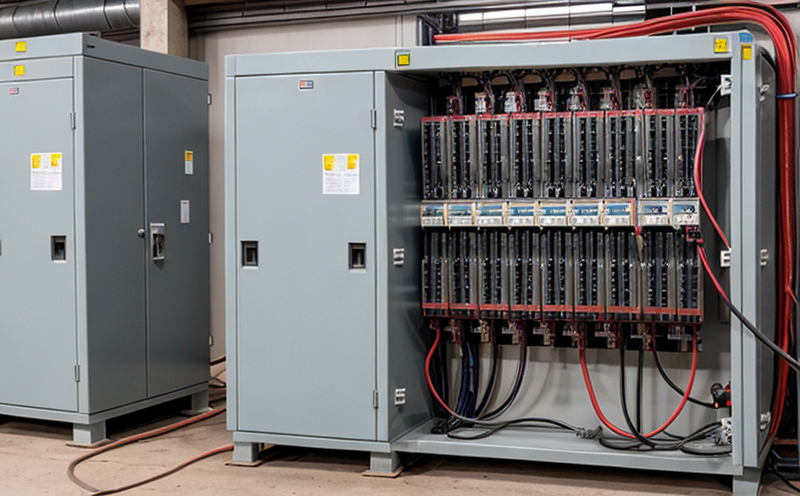IEC 62271-304 Temperature Rise Testing of Switchgear
The IEC (International Electrotechnical Commission) 62271-304 standard provides essential guidelines for the temperature rise testing of switchgear. This service is critical in ensuring that electrical equipment meets safety and performance standards, which are crucial for preventing accidents and ensuring reliability in power distribution systems.
The process involves subjecting switchgear to specific loading conditions and measuring the resulting temperature increase over a defined period. Compliance with this standard ensures that the switchgear can handle its rated load without compromising on insulation integrity or mechanical stability. This testing is vital for quality managers, compliance officers, R&D engineers, and procurement teams involved in selecting and certifying electrical equipment.
The testing procedure typically involves several steps, including setting up the test rig, applying specified loading conditions, monitoring temperature changes, and comparing results against predefined acceptance criteria. The apparatus used includes high-precision thermocouples to measure temperature accurately during the testing process.
Customer satisfaction in this sector is paramount due to the critical role of switchgear in power distribution systems. Ensuring that equipment meets IEC 62271-304 standards not only enhances safety but also contributes significantly to operational efficiency and long-term cost savings for utilities and industrial clients.
- Enhanced Safety: Compliance with the standard ensures that switchgear can withstand high loads without overheating, reducing the risk of electrical fires or equipment failures.
- Operational Efficiency: Testing ensures that switchgear operates at optimal temperatures, minimizing downtime and maintenance costs.
- Regulatory Compliance: Meeting IEC 62271-304 standards is essential for compliance with international regulations governing electrical equipment.
The testing procedure is designed to simulate real-world conditions that the switchgear will encounter during its operational life. This includes applying rated short-circuit currents and measuring temperature rise over a specified duration. The results of these tests are crucial in validating that the switchgear can function safely under expected operating conditions.
For R&D engineers, this service provides valuable insights into material properties and design improvements needed to enhance performance and safety. For quality managers, it ensures consistent product quality across production batches. Compliance officers benefit from verifying adherence to international standards, which is essential for market access and regulatory compliance.
In summary, the IEC 62271-304 Temperature Rise Testing of Switchgear is a vital service that contributes significantly to the reliability, safety, and operational efficiency of power distribution systems. By adhering to this standard, utilities and industrial clients can ensure that their switchgear meets stringent performance requirements, thereby protecting personnel and infrastructure.
Customer Impact and Satisfaction
The IEC 62271-304 Temperature Rise Testing of Switchgear has a profound impact on customer satisfaction by ensuring that electrical equipment meets the highest safety and performance standards. This service directly contributes to the reliability, efficiency, and longevity of power distribution systems.
- Improved Safety: By adhering to this standard, utilities and industrial clients can ensure that their switchgear operates safely under all conditions.
- Increased Efficiency: Testing ensures that equipment performs optimally, reducing downtime and maintenance costs.
- Enhanced Reputation: Compliance with international standards enhances the reputation of manufacturers and operators in the power sector.
The results of this testing are crucial for maintaining regulatory compliance, which is essential for market access. Utilities benefit from a safer and more reliable power supply, while industrial clients enjoy improved operational efficiency and reduced maintenance costs. Overall, this service plays a vital role in ensuring that switchgear meets the stringent performance requirements set by international standards.
Competitive Advantage and Market Impact
The IEC 62271-304 Temperature Rise Testing of Switchgear provides significant competitive advantages for manufacturers, operators, and utilities. By ensuring that switchgear meets the highest safety and performance standards, businesses can differentiate themselves in a crowded market.
- Regulatory Compliance: Compliance with international standards is essential for market access and regulatory compliance.
- Enhanced Reputation: Adherence to these standards enhances the reputation of manufacturers and operators, leading to increased customer confidence.
- Innovation and Improvement: The testing process provides valuable insights into material properties and design improvements, driving innovation and continuous improvement.
The market impact of this service is substantial. By ensuring that switchgear meets the highest safety and performance standards, businesses can maintain a strong competitive position in an increasingly regulated environment. This service contributes to the overall reliability and efficiency of power distribution systems, which are critical for utilities and industrial clients.
Use Cases and Application Examples
The IEC 62271-304 Temperature Rise Testing of Switchgear is applicable in a wide range of use cases across various sectors. This testing is particularly crucial for power distribution networks, substations, industrial plants, and data centers.
- Power Distribution Networks: Ensures that switchgear can handle high loads without overheating, reducing the risk of equipment failure and ensuring reliable power supply.
- Substations: Guarantees that critical components operate safely under all conditions, minimizing downtime and maintenance costs.
- Industrial Plants: Ensures that switchgear meets stringent performance requirements, enhancing operational efficiency and safety.
- Data Centers: Provides assurance that equipment can handle high loads without compromising on insulation integrity or mechanical stability, ensuring continuous operation.
The application examples include testing new models of switchgear before mass production to ensure compliance with international standards. It also involves periodic testing for existing installations to verify continued performance and safety over time. This service is essential for quality managers, R&D engineers, and compliance officers in these sectors.





